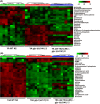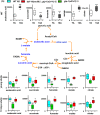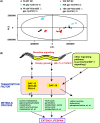Metabolomic signature associated with reproduction-regulated aging in Caenorhabditis elegans
- PMID: 28177875
- PMCID: PMC5361674
- DOI: 10.18632/aging.101170
Metabolomic signature associated with reproduction-regulated aging in Caenorhabditis elegans
Abstract
In Caenorhabditis elegans (C. elegans), ablation of germline stem cells (GSCs) leads to infertility, which extends lifespan. It has been reported that aging and reproduction are both inextricably associated with metabolism. However, few studies have investigated the roles of polar small molecules metabolism in regulating longevity by reproduction. In this work, we combined the nuclear magnetic resonance (NMR) and ultra-performance liquid chromatography-mass spectrometry (UPLC-MS) to profile the water-soluble metabolome in C. elegans. Comparing the metabolic fingerprint between two physiological ages among different mutants, our results demonstrate that aging is characterized by metabolome remodeling and metabolic decline. In addition, by analyzing the metabolic profiles of long-lived germline-less glp-1 mutants, we discovered that glp-1 mutants regulate the levels of many age-variant metabolites to attenuate aging, including elevated concentrations of the pyrimidine and purine metabolism intermediates and decreased concentrations of the citric acid cycle intermediates. Interestingly, by analyzing the metabolome of daf-16;glp-1 double mutants, our results revealed that some metabolic exchange contributing to germline-mediated longevity was mediated by transcription factor FOXO/DAF-16, including pyrimidine metabolism and the TCA cycle. Based on a comprehensive metabolic analysis, we provide novel insight into the relationship between longevity and metabolism regulated by germline signals in C. elegans.
Keywords: Caenorhabditis elegans; UPLC-MS and NMR; aging; metabolome; reproduction.
Conflict of interest statement
The authors declare that there is no conflict of interest.
Figures







Similar articles
-
The Effects of Age and Reproduction on the Lipidome of Caenorhabditis elegans.Oxid Med Cell Longev. 2019 May 9;2019:5768953. doi: 10.1155/2019/5768953. eCollection 2019. Oxid Med Cell Longev. 2019. PMID: 31249646 Free PMC article.
-
The protein kinase MBK-1 contributes to lifespan extension in daf-2 mutant and germline-deficient Caenorhabditis elegans.Aging (Albany NY). 2017 May 25;9(5):1414-1432. doi: 10.18632/aging.101244. Aging (Albany NY). 2017. PMID: 28562327 Free PMC article.
-
Intermediate metabolites of the pyrimidine metabolism pathway extend the lifespan of C. elegans through regulating reproductive signals.Aging (Albany NY). 2019 Jun 21;11(12):3993-4010. doi: 10.18632/aging.102033. Aging (Albany NY). 2019. PMID: 31232697 Free PMC article.
-
DAF-16/FoxO in Caenorhabditis elegans and Its Role in Metabolic Remodeling.Cells. 2020 Jan 2;9(1):109. doi: 10.3390/cells9010109. Cells. 2020. PMID: 31906434 Free PMC article. Review.
-
A pathway that links reproductive status to lifespan in Caenorhabditis elegans.Ann N Y Acad Sci. 2010 Aug;1204:156-62. doi: 10.1111/j.1749-6632.2010.05640.x. Ann N Y Acad Sci. 2010. PMID: 20738286 Review.
Cited by
-
Metabolome Profiling in Aging Studies.Biology (Basel). 2022 Oct 26;11(11):1570. doi: 10.3390/biology11111570. Biology (Basel). 2022. PMID: 36358271 Free PMC article. Review.
-
IDH-1 deficiency induces growth defects and metabolic alterations in GSPD-1-deficient Caenorhabditis elegans.J Mol Med (Berl). 2019 Mar;97(3):385-396. doi: 10.1007/s00109-018-01740-2. Epub 2019 Jan 19. J Mol Med (Berl). 2019. PMID: 30661088 Free PMC article.
-
Sanghuangporus sanghuang extract extended the lifespan and healthspan of Caenorhabditis elegans via DAF-16/SIR-2.1.Front Pharmacol. 2023 Apr 20;14:1136897. doi: 10.3389/fphar.2023.1136897. eCollection 2023. Front Pharmacol. 2023. PMID: 37153808 Free PMC article.
-
Multi-Omics and Genome-Scale Modeling Reveal a Metabolic Shift During C. elegans Aging.Front Mol Biosci. 2019 Feb 6;6:2. doi: 10.3389/fmolb.2019.00002. eCollection 2019. Front Mol Biosci. 2019. PMID: 30788345 Free PMC article.
-
Methionine Supplementation Alleviates the Germ Cell Apoptosis Increased by Maternal Caffeine Intake in a C. elegans Model.Nutrients. 2024 Mar 20;16(6):894. doi: 10.3390/nu16060894. Nutrients. 2024. PMID: 38542805 Free PMC article.
References
Publication types
MeSH terms
Substances
Grants and funding
LinkOut - more resources
Full Text Sources
Other Literature Sources
Medical
Miscellaneous

